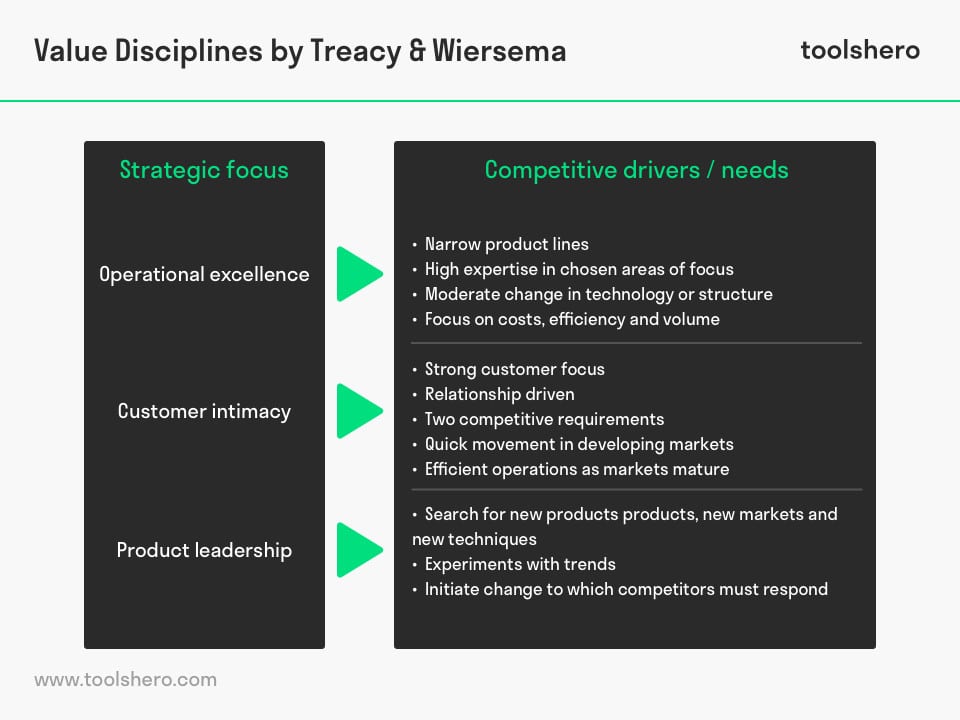Value Disciplines Model by Treacy and Wiersema

Value Disciplines: this article explains Value Disciplines, by Michael Treacy and Fred Wiersema in a practical way. After reading you will understand the basics of this powerful strategy tool.
What are Value Disciplines?
In Value Disciplines Michael Treacy and Fred Wiersema make the assumption that an organization will always excel in that which it is good at. This value position is determined by the opinion of external parties such as for example the organization’s customers and suppliers.
The value position of an organization is not only determined by price but also by other factors such as the effort someone has to make to purchase the product/service.
Rules of procedure
In order to take up a good value position, Michael Treacy and Fred Wiersema mention four rules of procedure an organization has to observe:
- Rule no. 1: Try to be the best by excelling in one of the value disciplines.
- Rule no. 2: Maintain threshold standards on other value disciplines.
- Rule no. 3: Control the market by improving value year after year.
- Rule no. 4: Support the value discipline you have opted for by delivering a well-chosen (operating) organizational model.
Three types of Value Disciplines
When these rules have been complied with, Michael Treacy and Fred Wiersema distinguish three value disciplines.
Operational Excellence
An organization that focuses on cost leadership will always aim at providing its customers with high quality products or services at competitive prices and ease of purchase.
The organization focuses internally on the streamlining of processes. Making as few errors as possible, minimizing superfluous service, standardizing and increasing (economies of scale) are part of this procedure.
Examples of such organizations are: Dell, Walmart, American Airlines, Federal Express, EasyJet and RyanAir.
Customer Intimacy
The organization feels that its customers are the most important aspect of its organization. The organization is continuously working to meet the customer’s requirements and delivers mainly tailor-made work and one-on-one solutions in which the organization focuses on a long-term customer relationship.
Obtaining a once-only (large) transaction is subordinate to creating a long-lasting intimacy bond.
In order to excel in this strategy, organizations often use an intensive Customer Relations Management (CRM). Examples of such organizations are: Home Depot, Staples in office-supply retailing, Ciba-Geigy in pharmaceuticals, Kraft and Frito-Lay in consumer packaged goods.
Product Leadership
An organization that focuses on product leadership will always strive for product development and product innovation and want to be market leader of the specific product and/ or service (state-of-the-art products).
They strive to create a continuous stream of innovation that is in demand with both loyal and new buyers. The organization invests much in Research & Development.
This organization has a flexible structure and stimulates the performance and creativity of its employees. The new and innovative products are often ‘better, smaller, faster, trendier and cheaper’ than their previous products. Examples of leading companies are: Apple, Bang & Olufsen, Philips.
It’s Your Turn
What do you think? Are the Value Disciplines applicable in today’s modern companies? Do you recognize the practical explanation or do you have more suggestions? What are your success factors for following a type of Value Disciplines?
Share your experience and knowledge in the comments box below.
More information
- Wiersema, F. (2002). The New Market Leaders: Who’s Winning and how in the Battle for Customers. Simon and Schuster.
- Treacy, M. & Wiersema, F. (1994). The discipline of market leaders: Choose your customers, narrow your focus, dominate your market. Basic Books.
- Treacy, M. & Wiersema, F. (1993). Customer intimacy and other value disciplines. Harvard Business Review, 71 1) 84–93.
How to cite this article:
Van Vliet, V. (2011). Value Disciplines (Treacy and Wiersema). Retrieved [insert date] from Toolshero: https://www.toolshero.com/strategy/value-disciplines-treacy-wiersma/
Original publication date: 01/03/2011 | Last update: 01/09/2024
Add a link to this page on your website:
<a href=”https://www.toolshero.com/strategy/value-disciplines-treacy-wiersma/”>Toolshero: Value Disciplines (Treacy and Wiersema)</a>














3 responses to “Value Disciplines Model by Treacy and Wiersema”
I find it a fantastic approach. It helps a lot form strategy to system delivery service and product as well. These three strategic focus were mentioned before by Michael Porter, “Competitive Strategy”, chapter 2 generic competitive strategies (cost leadership, differentiation, and highly segmented) in 1982.
It also was part of the lecture of Service Quality, transactional, customer intimacy (niche) and innovation. By Professor Tony Bendell at Nottingham Trent University, UK. As part of MSc. in Quality Management and Improvement, 1996. Based on the book “benchmarking customer service” Glen Peters, 1994.
Thank you for your feedback and sharing your insights on this topic Luis. I am glad that you found the article interesting.
very good article